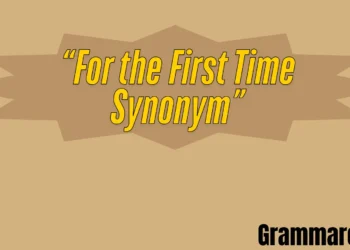Finding the right words for communications through sending online email and receiving text is a big difference. “For Your Reference” is a staple in professional communication, particularly in written formats like emails and reports. It serves to provide information, documents, or data that the recipient might find useful. By using this phrase, the sender indicates that the material is being shared to assist or inform without necessarily expecting immediate action or response.
Advantages and Disadvantages of using the phrase “For Your Reference”
Advantages of Using “For Your Reference”
- Non-Intrusive—Let recipients know the information is available without pressuring them to act.
- Professional & Organized—Maintains a formal tone while keeping records clear.
- Future-Proofing—Ensures recipients have access to key details when needed.
- Avoids Miscommunication—Clearly distinguishes reference material from action items.
- Versatile—works for emails, reports, presentations, and document sharing.
Disadvantages of Overusing or Misusing “For Your Reference”
- Passive Tone—May seem dismissive if used for critical information.
- Ignored recipients might skip reading if they assume it’s unimportant.
- Vagueness—Without context, the recipient may not understand its relevance.
- Overuse—Loses impact if attached to every minor document.
- Wrong Audience—Irrelevant references can clutter inboxes and waste time.
What “For Your Reference” Means
- Definition: A polite way to provide supplementary documents or background information.
- Purpose: To inform, document, or support without requiring action.
- Key Uses:
- Sharing policies, guidelines, or templates.
- Attaching meeting minutes or reports for record-keeping.
- Sending legal/compliance documents (e.g., contracts, disclaimers).
- Providing research, data, or precedents for future use.
Are there polite and Professional Ways to Use “For Your Reference”?

That’s right, assist you further is a polite, professional phrase. A lot of business and official communication makes use of this expression to say they are providing something that’s useful or relevant that someone may need even if there is no expectation that person takes any particular action immediately.
1. Clear Subject Line
- “Document attached.”
- “Q3 Sales Report Attached for Your Reference”
2. Use in Formal vs. Informal Settings
- Formal (Clients/Executives):
“For your reference, the signed contract and payment terms are enclosed.” - Informal (Team Colleagues):
“FYR—meeting notes from today’s brainstorm!”
3. Pair with Action-Oriented Language (When Needed)
- “For your reference, the project timeline is attached. Let me know if you’d like to discuss adjustments.”
4. Avoid Redundancy
- ❌ “For your reference, please see the attached for your reference.”
- ✅ “For your reference, the budget breakdown is attached.”
35 Different Alternatives with Definition, Meaning, Explanation, Best and Worst Use, and Tone.
1. Time-Sensitive Material
- Meaning: Information with an expiration date.
- Definition: Content that loses relevance after the deadline.
- Explanation: Helps recipients prioritize workflow.
- Example: “The limited-time offer details are time-sensitive material—respond by Friday.”
- Best Use: Promotions, deadlines, or expiring opportunities.
- Worst Use: Evergreen policies.
- Tone: Alerting, precise.
2. Prompt Response Appreciated
- Meaning: Politely requesting a quick reply.
- Definition: A courteous way to ask for a fast response.
- Explanation: Often used when time is important but the tone remains polite.
- Example: Prompt response appreciated: please confirm your attendance at the meeting.”
- Best Use: Situations requiring quick but courteous feedback.
- Worst Use: Non-urgent matters.
- Tone: Polite, respectful.
3. For Your Knowledge
- Meaning: Provides background or contextual information.
- Definition: Shares details to enhance understanding without direct relevance to tasks.
- Explanation: Useful for educating recipients indirectly.
- Example: “For your knowledge, our competitor launched a similar product last quarter.”
- Best Use: Strategic or industry insights.
- Worst Use: Time-sensitive directives.
- Tone: Educational, supportive.
4. Just to Note
- Meaning: Casually highlights minor but noteworthy details.
- Definition: A low-pressure way to point out small changes or reminders.
- Explanation: Balances professionalism with approachability.
- Example: “Just to note, the client prefers email over calls.”
- Best Use: Minor protocol adjustments.
- Worst Use: Major policy shifts.
- Tone: Light, conversational.
5. Urgent Attention Needed
- Meaning: Requires immediate action or review
- Definition: Signals time-sensitive material demanding prompt response
- Explanation: Creates clear priority for critical matters
- Example: “The system outage report is attached—urgent attention needed by the IT team.”
- Best Use: Crisis management or operational emergencies
- Worst Use: Routine correspondence
- Tone: Pressing, authoritative
6. Attached for Review
- Meaning: Directs attention to a document needing examination.
- Definition: Used when feedback or approval is expected on an attachment.
- Explanation: Clearly sets expectations for recipient action.
- Example: “The contract draft is attached for review.”
- Best Use: Documents requiring feedback.
- Worst Use: When no response is needed.
- Tone: Direct, professional.
7. Enclosed for Your Records
- Meaning: Provides documentation for future reference.
- Definition: A formal way to share files that should be saved (e.g., receipts, contracts).
- Explanation: Emphasizes the importance of record-keeping.
- Example: “The signed NDA is enclosed for your records.”
- Best Use: Legal or financial documents.
- Worst Use: Casual team updates.
- Tone: Formal, administrative.
8. As a Future Resource
- Meaning: May be helpful or relevant later.
- Definition: Suggests that the content is a helpful tool or reference point for future work.
- Explanation: Common in training, onboarding, or knowledge-sharing settings.
- Example:As a future resource, I’ve created a checklist for onboarding new clients.”
- Best Use: Educational or support materials.
- Worst Use: Critical or urgent updates.
- Tone: Supportive, forward-looking.
9. To Validate
- Meaning: Evidence for substantiation
- Definition: Supports claims or decisions with proof
- Explanation: Builds credibility in professional arguments
- Example: “Case studies are included to validate our recommended approach.”
- Best Use: Business cases or proposals
- Worst Use: Routine internal communications
- Tone: Evidence-based, authoritative
10. Uploaded for Access
- Meaning: Indicates files are available in a shared system.
- Definition: Common in digital workspaces (e.g., cloud storage).
- Explanation: Highlights accessibility over attachment.
- Example: “The training videos are uploaded for access on SharePoint.”
- Best Use: Large or collaborative files.
- Worst Use: One-on-one document sharing.
- Tone: Technical, efficient.
11. For Your Perspective
- Meaning: Seeking a specific viewpoint or opinion.
- Definition: Directly asking someone to provide their personal view on a subject.
- Explanation: Often used in collaborative environments where diverse insights are needed.
- Example:Here’s the proposal. I’d appreciate your perspective on the new timeline.”
- Best Use: Team discussions, feedback sessions.
- Worst Use: When a decision needs to be made quickly.
- Tone: Collaborative, respectful.
12. Thought You Should Know
- Meaning: Indicates the sender believes the information is worth knowing.
- Definition: A personal judgment that the info is relevant to the recipient.
- Explanation: Best used when you’re confident the detail could influence someone’s work.
- Example: “Thought you should know—our competitor just launched a similar product.”
- Best Use: Informal insights or early warnings.
- Worst Use: Sharing speculative or unconfirmed news.
- Tone: Candid, watchful.
13. Respectfully Shared
- Meaning: Shared with a sense of deference and professionalism.
- Definition: Definition: shows that the sender offers facts courteously, usually in formal situations.
- Explanation: Appropriate for messages when the sender intends to show professionalism and courtesy.
- Example: “Respectfully shared, attached for your consideration are the meeting minutes.”
- Best Use: Formal communication with clients or senior leaders.
- Worst Use: Casual or informal communication.
- Tone: Polite, formal.
14. As a Heads-Up
- Meaning: Advance warning about an upcoming change.
- Definition: An Informal phrase meant to alert someone to prepare.
- Explanation: Communication is very common among the younger workers.
- Example: “As a heads-up, the report is due a day earlier than expected.
- Best Use: Informal updates that help others plan ahead.
- Worst Use: Formal documents or client communication.
- Tone: Casual, proactive
15. With All Due Respect
- Meaning: Honorific preface to information.
- Definition: Prefaces potentially challenging content.
- Explanation: Softens delivery of critical or sensitive material.
- Example: “With all due respect, I’m sharing alternative approaches for consideration.”
- Best Use: Challenging leadership decisions.
- Worst Use: Routine status updates.
- Tone: Deferential, tactful.
16. For Joint Consideration
- Meaning: Suggests evaluating something together.
- Definition: Indicates that both sender and recipient should review or reflect on the content.
- Explanation: Often precedes mutual decision-making.
- Example: “I’m submitting this draft for joint consideration in tomorrow’s session.”
- Best Use: Co-owned initiatives or negotiations.
- Worst Use: Simple updates or unilateral decisions.
- Tone: Thoughtful, diplomatic.
17. For Your Analysis
- Meaning: Indicates that the information is being shared to be analyzed or reviewed in depth.
- Definition: Directs the recipient to examine the contents critically.
- Explanation: Used in cases where the recipient is expected to assess the data or content.
- Example:Attached is the financial report for your analysis.”
- Best Use: Data-heavy or analytical tasks.
- Worst Use: Light, simple communication with no need for deep review.
- Tone: Professional, directive.
18. To Facilitate Your Task
- Meaning: To make the recipient’s responsibility easier.
- Definition: Indicates that the sender aims to smooth the workflow.
- Explanation: Great for sharing tools, summaries, or simplified instructions.
- Example: “To facilitate your task, here is a pre-filled template.”
- Best Use: When content actively saves the recipient time or effort.
- Worst Use: When tasks require personal or manual effort, regardless.
- Tone: Supportive, practical.
19. Just Sharing
- Meaning: Offering something informally without expecting a response.
- Definition: A casual phrase used to pass along details, mostly without urgency or required action.
- Explanation: Mostly in peer-to-peer communication where you’re simply spreading an update or awareness.
- Example: “Just sharing the latest client feedback from yesterday’s meeting.”
- Best Use: Informal updates among colleagues.
- Worst Use: Official or legal communications.
- Tone: Casual, friendly.
20. For Benchmarking
- Meaning: To compare or evaluate against a standard or reference.
- Definition: Sharing information to establish a baseline or comparison point.
- Explanation: Common in performance analysis or setting industry standards.
- Example:Here are the industry averages for benchmarking our upcoming project budget.”
- Best Use: Performance reviews, comparisons with best practices.
- Worst Use: Casual updates with no need for comparison.
- Tone: Analytical, structured.
21. Just Sharing
- Meaning: Casual transmission of information.
- Definition: Informal way to pass along documents or updates without expectation.
- Explanation: Creates low-pressure communication for non-critical items.
- Example: “Just sharing the meeting notes from today’s brainstorming session.”
- Best Use: Internal team communications where formality isn’t required
- Worst Use: Client communications or sensitive information.
- Tone: Friendly, relaxed.
22. . For Your Knowledge
- Meaning: Shared as helpful information, even if no action is needed.
- Definition: Indicates the content is for learning or background context.
- Explanation: Often used in learning environments or knowledge-sharing cultures.
- Example: “For your knowledge, this process has been updated as of July 1.”
- Best Use: Sharing documentation or reference material.
- Worst Use: When the content is irrelevant to the reader.
- Tone: Educational, professional.
23. Passing Along
- Meaning: Forwarding information from another source.
- Definition: Signals that you are performing the role of a channel and not an originator.
- Explanation: This is helpful for keeping interdepartmental processes coordinated.
- Example: “Relaying the client’s comments received during the focus group session.”
- Best Use: When relaying messages between teams/departments.
- Worst Use: When you should personally address the content.
- Tone: Neutral, transparent.
24. Thought You Should Know
- Meaning: Sharing potentially relevant information.
- Definition: Suggests information may impact the recipient’s work.
- Explanation: Shows consideration for the recipient’s needs.
- Example: “Thought you should know the marketing team changed their strategy.”
- Best Use: Cross-departmental awareness building.
- Worst Use: Gossip or unverified information.
- Tone: Collegial, helpful.
25. For Your Convenience
- Meaning: Prioritizes the recipient’s ease.
- Definition: Tailors information for quick consumption or use.
- Explanation: Demonstrates customer-service mindset.
- Example: “For your convenience, FAQs are summarized on page 2.”
- Best Use: Client-facing materials.
- Worst Use: Internal rough drafts.
- Tone: Considerate, polished.
26. For Your Input
- Meaning: Request for feedback or suggestions.
- Definition: Seeks recipient’s expertise or perspective.
- Explanation: Values recipient’s contribution to decision-making.
- Example: “The draft proposal is attached for your input.”
- Best Use: Collaborative document development.
- Worst Use: When decisions are already finalized.
- Tone: Collaborative, respectful.
27. For Your Support
- Meaning: Information provided to back the recipient’s efforts.
- Definition: Shared to strengthen or supplement work already underway.
- Explanation: Encourages continued progress by offering help.
- Example:For your support, attached is the market research requested.”
- Best Use: When helping someone complete a task or project.
- Worst Use: For irrelevant or extra materials.
- Tone: Collaborative, positive.
28. To Aid Your Process
- Meaning: Shared to help with the recipient’s workflow.
- Definition: Shows that the sender is considering how to support progress.
- Explanation: Ideal for managers or team members providing resources.
- Example:To aid your process, here’s a checklist we use internally.”
- Best Use: Offering tools, steps, or helpful frameworks.
- Worst Use: For routine updates or notices.
- Tone: Constructive, cooperative.
29. Requiring Your Signature
- Meaning: Needs physical/electronic authorization.
- Definition: For legally binding or formal agreements.
- Explanation: Specifies exact action needed.
- Example: “The contract is attached, requiring your signature.”
- Best Use: Legal documents, formal agreements.
- Worst Use: Informal team agreements.
- Tone: Official, procedural.
30. For Your Input
- Meaning: Inviting feedback or opinions.
- Definition: Indicates that the recipient’s review or suggestions are welcomed.
- Explanation: Often used in drafts, discussions, and decision-making.
- Example:”Please see the draft attached for your input before we proceed.”
- Best Use: Collaborating on documents or decisions.
- Worst Use: When feedback is not expected or wanted.
- Tone: Respectful, inclusive.
31. Uploaded for Access
- Meaning: Indicates files are available in a shared location.
- Definition: Lets the recipient know where they can retrieve content.
- Explanation: Helpful when sharing cloud-based or internal drive links.
- Example:The presentation has been uploaded for access to the shared folder.”
- Best Use: Cloud-based collaboration or large file sharing.
- Worst Use: When users aren’t familiar with the platform.
- Tone: Neutral, modern.
32. Attached for Review
- Meaning: Indicates a document is included for feedback.
- Definition: Used when expecting review, edits, or approval.
- Explanation: Makes it clear that the attached item needs attention.
- Example:Attached for review is the first draft of the proposal.”
- Best Use: Drafts, proposals, presentations needing edits.
- Worst Use: When no feedback is needed.
- Tone: Direct, action-oriented.
33. For Team Review
- Meaning: Collective examination of materials.
- Definition: Invites group feedback and consensus.
- Explanation: Promotes collaborative decision-making.
- Example: “The new guidelines are posted for team review.”
- Best Use: Policy changes affecting multiple stakeholders.
- Worst Use: Individual performance assessments.
- Tone: Inclusive, democratic.
34. Submitted for Your Approval
- Meaning: Request for authorization.
- Definition: Formal phrasing used when the recipient must approve something.
- Explanation: Frequently used in corporate or regulated environments.
- Example:Attached is the updated policy, submitted for your approval.”
- Best Use: Seeking managerial or executive sign-off.
- Worst Use: For minor information updates.
- Tone: Formal, deferential.
35. For Joint Consideration
- Meaning: Collaborative decision-making material.
- Definition: Documents requiring collective evaluation by multiple stakeholders.
- Explanation: Facilitates group decision processes by providing shared reference points.
- Example: “The three vendor proposals are attached for joint consideration at Wednesday’s meeting.“
- Best Use: Cross-departmental purchasing decisions.
- Worst Use: Routine individual approvals.
- Tone: Diplomatic, inclusive.
FAQs:
1. What are some alternatives to “For Your Reference”?
ANS. Phrases like “Enclosed for your records,” “To assist your work,” or “For your knowledge” are useful alternatives.
2. Is it necessary to explain the attachment after saying “For Your Reference”?
ANS. Yes, briefly stating why the material is relevant helps prevent confusion and adds context.
3. Can I use “For Your Reference” in the subject line?
ANS. Yes. Example: “Project Timeline—For Your Reference.”
4. Is “For Your Reference” a polite phrase?
ANS. Yes, it is widely accepted as polite and professional in business communication.
5 . When should I use “For Your Reference”?
ANS. Use it when sharing documents, data, or context that supports but doesn’t demand immediate action.
6. Can “For Your Reference” be used in reports or presentations?
ANS. Absolutely. It works well in professional documents where supplementary material is cited.
Conclusion on Using “For Your Reference”
The phrase “For Your Reference” can enable effortless sharing of information without immediate expectations of action, all while guiding the recipient appropriately thanks to its distinguishing clarity. This phrase sets supplementary documents apart from urgent requests, helping workers efficiently allocate their attention to tasks that need immediate prioritization, aiding an effective workflow. “For Your Reference” adds particular value to documentation in formal legal and financial correspondence since it helps maintain compliance and clear records.
Its use can be unintrusive while still informative if the correct balance is struck, making it appropriate for policies, reports, archived data, and beyond. To make “for your reference” effective, context is critical and should be provided. Briefly explaining why the reference material matters and its potential relevance can go a long way toward achieving efficiency., “For Your Reference” removes ambiguity and improves organizational structure by clarifying what the recipient is expected to do while still maintaining professionalism.








